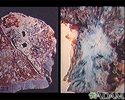PPD skin test
Purified protein derivative standard; TB skin test; Tuberculin skin test; Mantoux test
The PPD skin test is a method used to diagnose silent (latent) tuberculosis (TB) infection. PPD stands for purified protein derivative.
How the Test is Performed
You will need two visits to your health care provider's office for this test.
At the first visit, the provider will clean an area of your skin, usually the inside of your forearm. You will get a small shot (injection) that contains PPD. The needle is gently placed under the top layer of skin, causing a bump (welt) to form. This bump usually goes away in a few hours as the material is absorbed.
After 48 to 72 hours, you must return to your provider's office (in some cases, this can be done virtually). Your provider will check the area to see if you have had a strong reaction to the test.
How to Prepare for the Test
There is no special preparation for this test.
Tell your provider if you have ever had a positive PPD skin test. If so, you should not have a repeat PPD test, except under unusual circumstances.
Tell your provider if you have a medical condition or if you take certain medicines, such as steroids, which can affect your immune system. These situations may lead to inaccurate test results.
Tell your provider if you have received the BCG vaccine and if so, when you received it. (This vaccine is only given outside of the United States).
How the Test will Feel
You will feel a brief sting as the needle is inserted just below the skin surface.
Why the Test is Performed
This test is done to find out if you have ever come in contact with the bacteria that cause TB.
TB is an easily spread (contagious) disease. It most often affects the lungs. The bacteria can remain inactive (dormant) in the lungs for many years. This situation is called latent TB.
Most people in the United States who are infected with the bacteria do not have signs or symptoms of active TB.
You are most likely to need this test if you:
- May have been around someone with TB
- Work in health care
- Have a weakened immune system, due to certain medicines or disease (such as cancer or HIV/AIDS)
Normal Results
A negative reaction usually means you have never been infected with the bacteria that cause TB.
With a negative reaction, the skin where you received the PPD test is not swollen, or the swelling is very small. This measurement is different for children, people with HIV, and other high-risk groups.
The PPD skin test is not a perfect screening test. A few people infected with the bacteria that cause TB may not have a reaction. Also, diseases or medicines that weaken the immune system may cause a false-negative result.
What Abnormal Results Mean
An abnormal (positive) result means you have been infected with the bacteria that cause TB. You may need treatment to lower the risk of the disease coming back (reactivation of the disease). A positive skin test does not mean that a person has active TB. More tests must be done to check whether there is active disease.
A small reaction (5 mm of firm swelling at the site) is considered to be positive in people:
- Who have HIV/AIDS
- Who have received an organ transplant
- Who have a suppressed immune system or are taking steroid therapy (about 15 mg of prednisone per day for 1 month)
- Who have been in close contact with a person who has active TB
- Who have changes on a chest x-ray that look like past TB
Larger reactions (larger than or equal to 10 mm) are considered positive in:
- People with a known negative test in the past 2 years
- People with diabetes, kidney failure, or other conditions that increase their chance of getting active TB
- Health care workers
- Injection drug users
- Immigrants who have moved from a country with a high TB rate in the past 5 years
- Children under age 4
- Infants, children, or adolescents who are exposed to high-risk adults
- Students and employees of certain group living settings, such as prisons, nursing homes, and homeless shelters
In people with no known risks of TB, 15 mm or more of firm swelling at the site indicates a positive reaction.
People who were born outside the United States who have had a vaccine called BCG may have a false-positive test result.
Risks
There is a very small risk for severe redness and swelling of the arm in people who have had a previous positive PPD test and who have the test again. Generally, people who have had a positive test in the past should not be retested. This reaction can also occur in a few people who have not been tested before.
References
Fitzgerald DW, Sterling TR, Haas DW. Mycobacterium tuberculosis. In: Bennett JE, Dolin R, Blaser MJ, eds. Mandell, Douglas, and Bennett's Principles and Practice of Infectious Diseases. 9th ed. Philadelphia, PA: Elsevier; 2020:chap 249.
Rodino KG, Woods GL, Wengenack NL. Mycobacteria. In: McPherson RA, Pincus MR, eds. Henry's Clinical Diagnosis and Management by Laboratory Methods. 24th ed. Philadelphia, PA: Elsevier; 2022:chap 59.
Tuberculosis in the kidney - illustration
Tuberculosis in the kidney
illustration
Tuberculosis in the lung - illustration
Tuberculosis in the lung
illustration
Positive PPD skin test - illustration
Positive PPD skin test
illustration
PPD skin test - illustration
PPD skin test
illustration
Review Date: 11/23/2021
Reviewed By: Jatin M. Vyas, MD, PhD, Associate Professor in Medicine, Harvard Medical School; Associate in Medicine, Division of Infectious Disease, Department of Medicine, Massachusetts General Hospital, Boston, MA. Also reviewed by David Zieve, MD, MHA, Medical Director, Brenda Conaway, Editorial Director, and the A.D.A.M. Editorial team.






